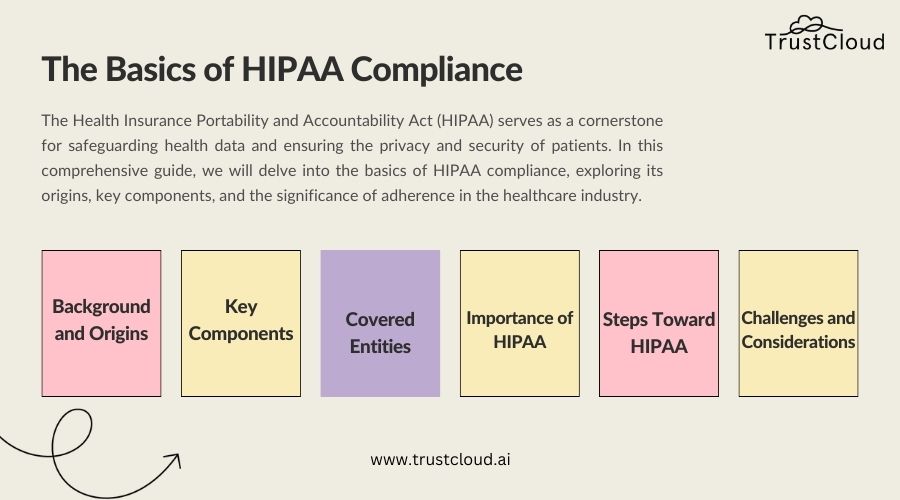In this article

Introduction:
In the healthcare sector, the protection of sensitive patient information is of utmost importance. The Health Insurance Portability and Accountability Act (HIPAA) serves as a cornerstone for safeguarding health data and ensuring the privacy and security of patients. In this comprehensive guide, we will delve into the basics of HIPAA compliance, exploring its origins, key components, and the significance of adherence in the healthcare industry.
Background and origins:
HIPAA, enacted in 1996, emerged as a response to rapidly advancing healthcare technologies and the need for a standardized framework to govern the use and disclosure of personal health information. The law aims to strike a balance between ensuring the seamless flow of health data for effective patient care and protecting individuals from unauthorized access to and use of their medical information.
Key components of HIPAA:
- Privacy rule:
The Privacy Rule establishes the standards for protecting individuals’ medical records and personal health information (PHI). It outlines the rights of patients regarding their health data and sets limits on the use and disclosure of such information by covered entities. - Security rule:
The Security Rule complements the Privacy Rule by focusing on the technical and physical safeguards required to secure electronic protected health information (ePHI). Covered entities are mandated to implement measures that ensure the confidentiality, integrity, and availability of ePHI. - Breach notification rule:
This rule outlines the obligations of covered entities and their business associates in the event of a breach involving unsecured PHI. It requires entities to notify affected individuals, the Secretary of Health and Human Services, and, in certain cases, the media. - Enforcement rule:
The Enforcement Rule details the procedures, investigations, and penalties that the Office for Civil Rights (OCR) may impose on entities found in violation of HIPAA rules. Penalties can range from fines to corrective action plans, depending on the severity of the non-compliance.
Covered entities and business associates:
To whom does HIPAA apply? Covered entities include healthcare providers, health plans, and healthcare clearinghouses. Additionally, business associates—entities that perform functions involving the use or disclosure of PHI on behalf of covered entities—are also subject to HIPAA regulations.
Importance of HIPAA compliance:
- Patient trust:
HIPAA compliance is integral to fostering and maintaining patient trust. When individuals know that their health information is handled with the utmost care and confidentiality, they are more likely to engage openly with healthcare providers, facilitating better medical care. - Legal and reputational protection:
Adherence to HIPAA regulations safeguards covered entities from legal consequences and protects their reputation. Non-compliance can result in severe penalties, legal action, and damage to an organization’s standing within the healthcare community. - Data security:
With the increasing digitization of health records, the Security Rule under HIPAA ensures that ePHI is secure. By implementing robust security measures, covered entities mitigate the risk of data breaches and unauthorized access to sensitive health information. - Standardization and interoperability:
HIPAA sets standardized protocols for the exchange of health information, promoting interoperability among different healthcare entities. This standardization enhances the efficiency and effectiveness of healthcare delivery, especially in a landscape where data sharing is crucial for patient care.
Steps toward HIPAA compliance:
- Conducting a risk analysis:
Covered entities must perform a comprehensive risk analysis to identify and assess potential vulnerabilities in the handling of PHI. This analysis forms the basis for developing risk management strategies. - Developing policies and procedures:
Creating and implementing clear policies and procedures is fundamental to HIPAA compliance. These documents guide employees on how to handle PHI, ensuring consistency and adherence to regulations. - Employee training:
Educating employees about HIPAA regulations is essential. Training programs should cover the importance of safeguarding PHI, recognizing potential security risks, and understanding the consequences of non-compliance. - Implementing technical safeguards:
The Security Rule mandates the use of technical measures to protect ePHI. This includes encryption, access controls, and audit controls to monitor and track electronic access to health data. - Breach response plan:
Having a well-defined breach response plan is crucial. In the unfortunate event of a data breach, a prompt and effective response can minimize damage and demonstrate a commitment to mitigating the impact on affected individuals.
Challenges and future considerations:
While HIPAA has significantly improved the privacy and security of health information, challenges persist. The evolving landscape of healthcare technology, the rise of telemedicine, and the increasing complexity of cyber threats necessitate continuous updates and adaptations to HIPAA regulations.
Looking ahead, the incorporation of emerging technologies such as blockchain and artificial intelligence into healthcare will require thoughtful integration with existing HIPAA frameworks. Balancing innovation with compliance will be key to addressing new challenges without compromising the security and privacy of patient information.
Summary:
In conclusion, understanding the basics of HIPAA compliance is essential for all entities involved in healthcare. By adhering to the principles and regulations outlined in HIPAA, covered entities and their business associates not only protect themselves from legal repercussions but also contribute to building a foundation of trust with patients. As the healthcare industry continues to evolve, so too will the importance of HIPAA compliance in safeguarding the integrity, confidentiality, and availability of health information.
Sign up with TrustCloud to learn more about how you can upgrade GRC into a profit center by automating your organization’s governance, risk management, and compliance processes.
Explore our GRC launchpad to gain expertise on numerous GRC topics and compliance standards.
